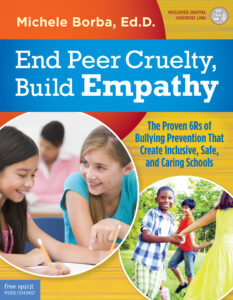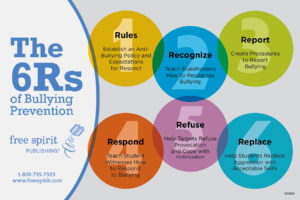What does it take to really end school violence and bullying? Let’s get real: Ultimately, what works to reduce bullying is not one time assemblies or posters but consistently relying on a few key evidence-based bullying prevention policies, principles, and practices tailored to your classroom or school. Let’s stop reacting and using quick-fix, band-aid approaches. Our kids deserve safe schools and caring educators using research based strategies can stop youth violence.
Bullying remains a serious problem in many schools today. Whether a child is bullying others, witnessing bullying, or the target of bullying, the behavior wreaks havoc on children’s emotional, moral, and cognitive development; demolishes feelings of safety; and, if not stopped, can shatter young lives. In fact, bullying is viewed as one of the most serious public health problems in our school systems. But bullying is learned, and it can be unlearned.
Caring, committed educators using research-based strategies can turn this terrible trend around. Eye-catching posters and buttons, T-shirt contests and one day bullying workshops are not effective solutions.
I’ve studied youth violence and bullying for over thirty years and wrote a bill on how to stop school shootings. That was passed by the state of California. But we have serious work to do. Our children are hurting. And an investigation of school shootings by the Secret Service found that almost three fourths of school shooters were bullied. Bullying effects all children: Children who bully, children who are targeted and children who witness the cruelty.
End Peer Cruelty, Build Empathy: The Proven 6Rs of Bullying Prevention That Create Inclusive, Safe and Caring Schools offers the strongest elements of best practices and bullying prevention programs to form the 6Rs of bullying prevention: Rules, Recognize, Report, Respond, Refuse, and Replace. Creating a caring school climate is not a quick fix, but a systemic, deliberate approach involving all stakeholders. Which elements are missing in your school’s prevention plans? End Peer Cruelty, Build Empathy provides proven solutions.
Part I: Establishing the Foundation of Bullying Prevention—Respectful Relationships and a Safe, Inclusive School Climate
The first part of effective bullying prevention is creating a safe and caring learning community to support all students’ cognitive, social, moral, and emotional development. Doing so will not only prevent bullying and other forms of aggression, but also increase student achievement, enhance school connectedness and safety, and reduce potential drop-out rates—all because you’re developing an environment where students want to “drop in” not “drop out.” Key bullying prevention points:
The most effective bullying prevention efforts address the whole school, classrooms, and individual students.
Bullying is far less likely to happen in classrooms and school cultures where caring and respect are the norms.
Positive school climates are places that promote and teach prosocial behaviors.
All adults need to promote and model respectful attitudes and behaviors.
Adults must create the trust that will help students come forward if they are bullied or witness bullying.
Respectful relationships—staff, students and parents, are the ultimate antidote to bullying.
Part II: Getting Started to Make Real and Lasting Change
The second part of effective bullying prevention involves creating a bullying prevention team, delegating roles and responsibilities to maximize your impact, and then selecting the best programs and practices to help reduce bullying in your unique school environment. Key bullying prevention points:
A comprehensive, school-wide approach to bullying prevention starts with a group of committed staff members chaired by a strong leader.
Effective bullying prevention isn’t a prepackaged program but driven by evidence.
Bullying assessments are critical and should include a range of formal and informal assessments that identify bullying types, targets, children who bully, the prevalence and frequency of aggressive behaviors, as well as the hot spots and times.
One of the most effective means of bullying assessment is to hold student focus groups.
Student bullying surveys provide data about your efforts and whether they are preventing and reducing peer cruelty.
For a program to be successful, it needs to be implemented as specified and then used as a systemic, sustained endeavor.
Any bullying prevention practice or program should fit the needs of your particular culture and students’ ages and abilities, and it should be based on your data.
Part III: The 6Rs of Bullying Prevention—Rules, Recognize, Report, Respond, Refuse, Replace
R1 Rules—Establish an Anti-Bullying Policy and Expectations for Respect
The first “R” of bullying prevention is to create a school-wide set of rules involving bullying—an anti-bullying policy. An anti-bullying policy alone won’t stop bullying, but it can be the first step toward mobilizing stakeholders to realize that together you can make a difference. An effective policy fits your school values and district and state statutes, focuses on prevention, features strong parental involvement, builds a respectful climate, and gets everyone onboard. Key bullying prevention points:
Strive to involve all stakeholders-staff, students, parents, and community members-in your bullying prevention efforts.
Identify strong anti-bullying practices and procedures; develop a policy that fits your culture and students’ needs.
Develop a clear definition of bullying that is easily understood and interpreted by all
Create an anti-bullying policy that specifies tiered bullying consequences and considers ages, maturity, intent, frequency.
Introduce your policy to all community members who can be instrumental in offering support for your efforts.
Introduce parents to your policy and procedures and help them understand that you will involve them in your efforts.
Help students form and agree on respectful class rules specifically about bullying.
R2 Recognize—Teach Stakeholders How to Recognize Bullying
The second “R” of bullying prevention is ensuring that all stakeholders in the process—students, staff, parents, and community members—learn to recognize bullying behavior and use the same definition. Key bullying prevention points:
Teach all stakeholders to recognize bullying behaviors and be on the same page to respond quickly and appropriately.
Conduct ongoing training about bullying and ensure that school’s policy and processes are effective and proven.
Find ways to help everyone in your community recognize bullying behaviors so they can respond.
Ensure staff, students, and parents are unified in their understanding of what bullying to respond as a unified team.
Educate parents in bullying prevention. Parent education is an essential piece of effective bullying prevention.
R3 Report—Create Procedures to Report Bullying
The third “R” of bullying prevention is to create solid, clear procedures for all stakeholders to report bullying. Key bullying prevention points:
Institute a policy requiring all stakeholders, including parents, to report bullying incidents or threats.
Create multiple procedures (including anonymity) for reporting bullying incidents.
Take measures to nurture staff and student relationships so kids feel more comfortable making reports.
Convince students that they will be heard and you will back them up if they report.
Have student teams speak directly to peers about the importance of reporting bullying.
Train peer mentors to receive reports of bullying from other students.
Teach students the difference between tattling and reporting and help break the “do not snitch” code.
R4 Respond—Teach Student Witnesses How to Respond to Bullying
The fourth “R” is devoted to the students who witness bullying. They are victims, too, and can be tremendous help in bullying prevention. How spectators respond to the child who is bullying, the target, or other bystanders can dramatically increase or decrease the intensity and duration of the bullying. Key bullying prevention points:
Bullying almost always occurs when adults aren’t in the vicinity to help: identify “hot spots” and supervise them.
Mobilize student compassion and create an environment where the majority of students support bully-free norms.
Teach students specific Bully BUSTER skills and practice so they can confidently use during an actual bullying incident.
To activate bystanders’ courage, students must know when to step in and how to help, and then believe that adults will give them the permission to do so.
R5—Refuse: Help Targets Refuse Provocation and Cope with Victimization
The fifth “R” of effective bullying prevention helps educators identify students who are vulnerable to bullying and teach them skills to refuse provocation, increase their safety, and cope with the effects of bullying. Key bullying prevention points:
Review reports to gather names of targeted students.
Notify appropriate staff, psychological services, and parents. Develop a safety plan to provide support for targets.
Build adult relationships with targets so they are more likely to seek help.
Provide “I Need Help” cards for nonverbal/shier students to present to an adult for help without saying anything.
Create “peer buddies”: older students who can watch, protect, or help targets on the school hot spots
Teach targets strategies to reduce victimization, such as assertiveness training and ways to cognitively reframe events.
Train staff to recognize the hidden signs of bullying and identify targets or potential targets.
Make certain your school colleagues know the warning signs of depression and how to intervene if necessary.
R6 Replace—Help Students Replace Aggression with Acceptable Behaviors
The sixth “R” of effective bullying prevention focuses on replacing cruelty with kindness. Because aggressive, cruel behaviors are learned and can become entrenched at an early age, we need to uncover as early as possible what is motivating a child to bully so we can address those specific issues and teach healthier ways of relating. Key bullying prevention points:
Look for patterns of aggression, and then chart all findings in staff reports to help uncover bullying motivators.
Train all adults staff members in ways to respond safely and effectively during and after a serious bullying incident.
Inconsistent staff responses to bullying increase the chances of bullying and aggression: find ways to boost consistency.
Create a system to monitor students who are bullying and pass it on to all staff members.
Bullying interventions must match the child’s needs, be evidence-based, and implemented by trained professionals.
Train educators in signs depression and anxiety and get students needed help and support.
Stress positive discipline approaches—not zero tolerance. Use restorative justice to repair relationships and boost respect
Help students replace aggression with more acceptable behaviors and provide practice until replacer behaviors are habits
 Based on a practical, six-part framework for reducing peer cruelty and increasing positive behavior support, End Peer Cruelty, Build Empathy utilizes the strongest pieces of best practices and current research for ways to stop bullying. The book includes guidelines for implementing strategies, collecting data, training staff, mobilizing students and parents, building social-emotional skills, and sustaining progress, and presents the “6Rs” of bullying prevention: Rules, Recognize, Report, Respond, Refuse, and Replace. This is not a program, but a comprehensive process for reducing bullying from the inside out, involving the entire school community. Use the book on its own or to supplement an existing program. Digital content includes customizable forms and a PDF presentation for use in professional development.
Based on a practical, six-part framework for reducing peer cruelty and increasing positive behavior support, End Peer Cruelty, Build Empathy utilizes the strongest pieces of best practices and current research for ways to stop bullying. The book includes guidelines for implementing strategies, collecting data, training staff, mobilizing students and parents, building social-emotional skills, and sustaining progress, and presents the “6Rs” of bullying prevention: Rules, Recognize, Report, Respond, Refuse, and Replace. This is not a program, but a comprehensive process for reducing bullying from the inside out, involving the entire school community. Use the book on its own or to supplement an existing program. Digital content includes customizable forms and a PDF presentation for use in professional development.


